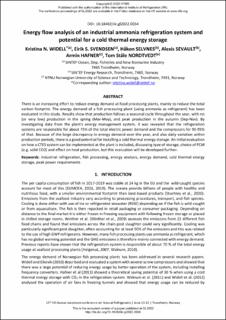Energy flow analysis of an industrial ammonia refrigeration system and potential for a cold thermal energy storage
Widell, Kristina Norne; Svendsen, Eirik Starheim; Selvnes, Håkon; Sevault, Alexis; Hafner, Armin; Nordtvedt, Tom Ståle
Chapter, Peer reviewed
Accepted version
Permanent lenke
https://hdl.handle.net/11250/3029917Utgivelsesdato
2022Metadata
Vis full innførselSamlinger
- Publikasjoner fra CRIStin - SINTEF Energi [1640]
- SINTEF Energi [1764]
- SINTEF Ocean [1461]
Originalversjon
15th IIR-Gustav Lorentzen Conference on Natural Refrigerants - GL2022 - Proceedings - Trondheim, Norway, June 13-15th 2022Sammendrag
There is an increasing effort to reduce energy demand at food processing plants, mainly to reduce the total carbon footprint. The energy demand of a fish processing plant (using ammonia as refrigerant) has been evaluated in this study. Results show that production follows a seasonal cycle throughout the year, with no (or very low) production in the spring (Mar-May), and peak production in the autumn (Sep-Nov). By investigating data from the plant's energy management system, it was revealed that the refrigeration systems are responsible for about 75% of the total electric power demand and the compressors for 90-95% of that. Because of the large discrepancy in energy demand over the year, and also daily variation within production periods, there is a good potential for installing a cold thermal energy storage. An initial evaluation on how a CTES system can be implemented at the plant is included, discussing type of storage, choice of PCM (e.g. solid CO2) and effect on heat production, but this evaluation will be developed further. Energy flow analysis of an industrial ammonia refrigeration system and potential for a cold thermal energy storage
